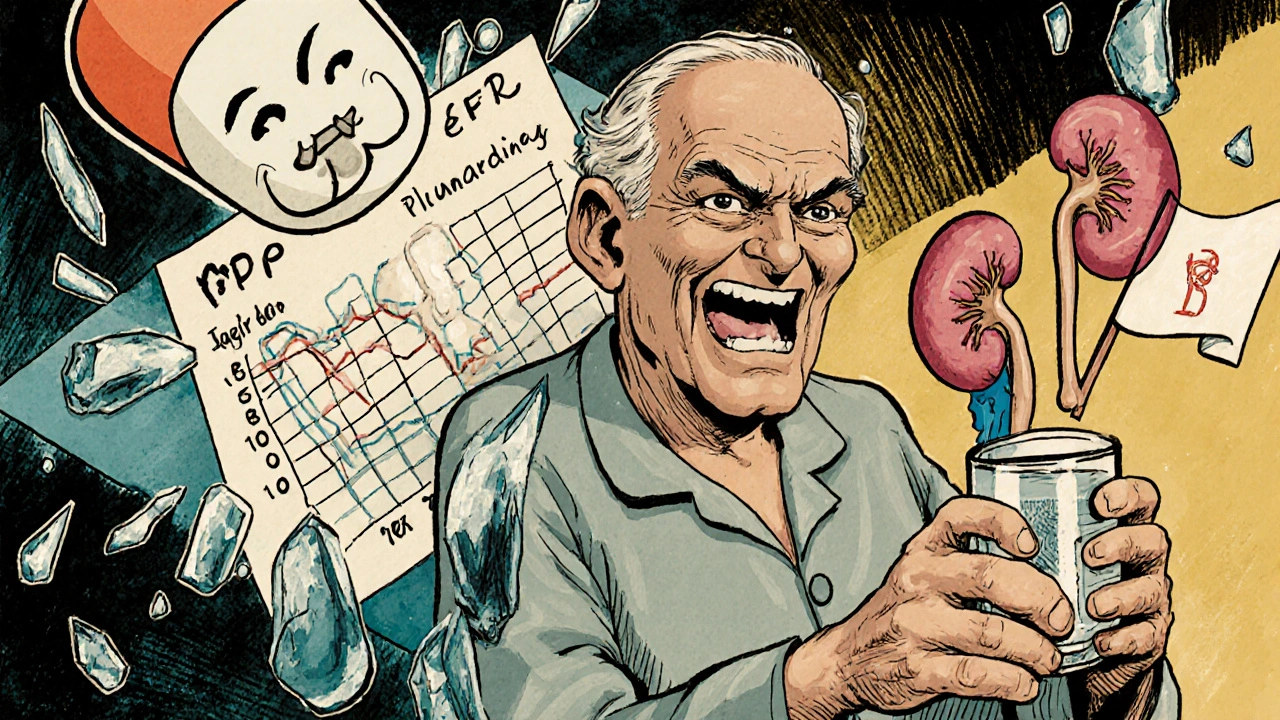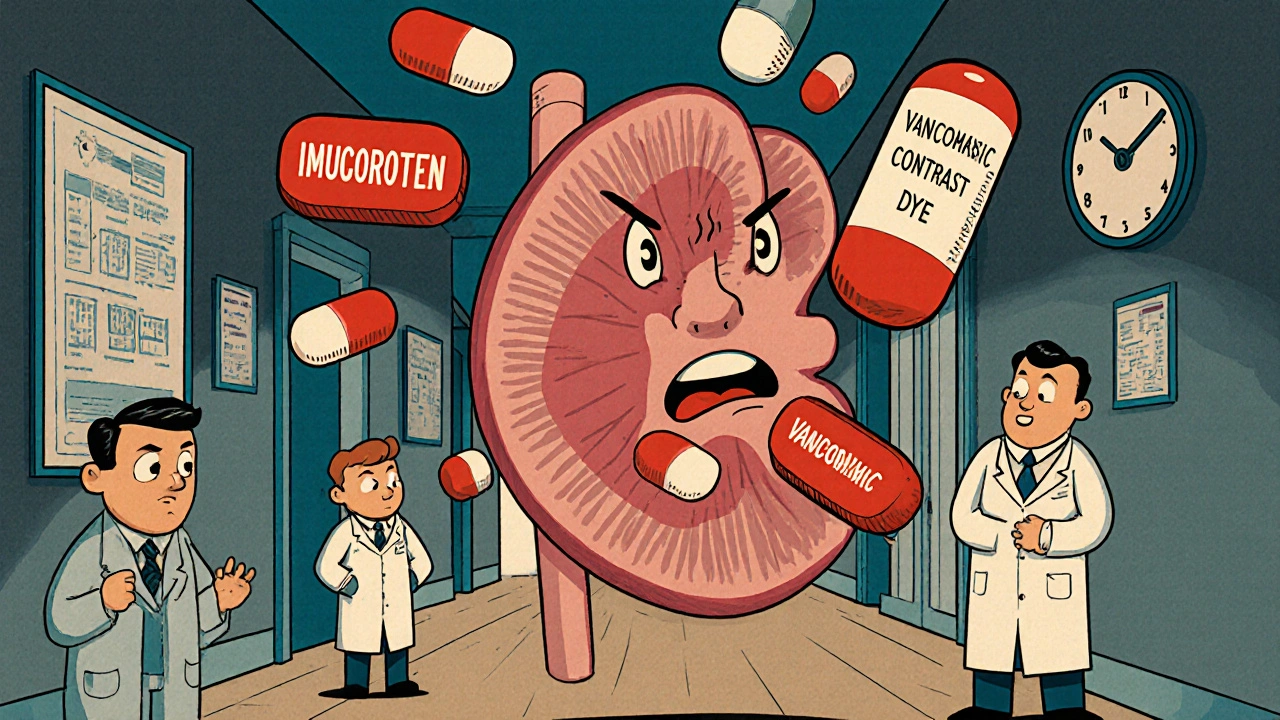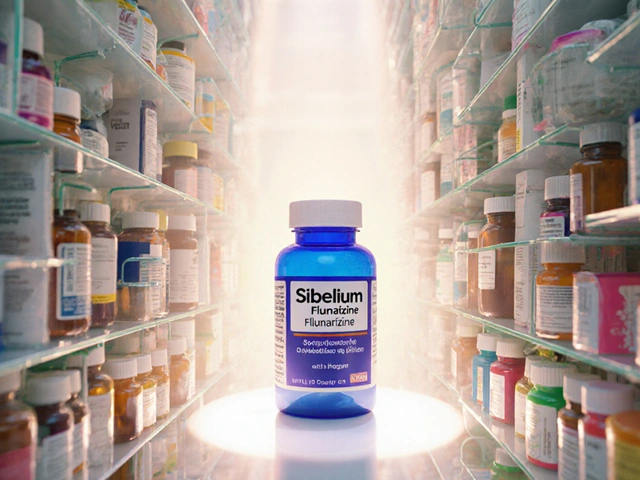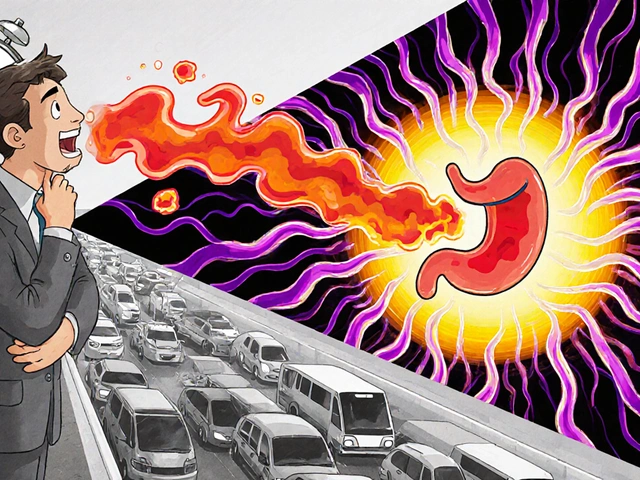Drug-Induced Kidney Injury Risk Calculator
Your Kidney Risk Assessment
Based on guidelines from KDIGO and the American Society of Nephrology
Your Kidney Health Report
Prevention Recommendations:
- Stay hydrated with at least 2L of water daily
- Monitor kidney function with regular creatinine tests
Every year, tens of thousands of people end up in the hospital with sudden kidney failure-not from diabetes, not from high blood pressure, but from something most people never think twice about: medication. Drug-induced kidney failure, officially called drug-induced acute kidney injury (DI-AKI), isn’t rare. It’s one of the most preventable causes of kidney damage in hospitals, yet it keeps happening because the signs are missed, the risks are ignored, and the right questions aren’t asked.
What Exactly Is Drug-Induced Kidney Failure?
It’s not a single disease. It’s a group of sudden kidney injuries triggered by medicines. The kidneys filter blood, and when certain drugs flood the system, they can clog tiny tubes, inflame tissue, or form crystals that block urine flow. The result? A rapid drop in kidney function-sometimes within hours.
The official definition from KDIGO (Kidney Disease: Improving Global Outcomes) is clear: if your creatinine rises by 0.3 mg/dL or more in 48 hours, or your urine output drops below 0.5 mL per kg per hour for six hours, you’re in acute kidney injury territory. And if a drug caused it? That’s DI-AKI.
Three main ways drugs hurt the kidneys:
- Acute interstitial nephritis: Your immune system reacts to the drug, causing swelling in the kidney’s filtering tissue. Common culprits? Proton pump inhibitors (like omeprazole), antibiotics (especially penicillins and sulfonamides), and NSAIDs like ibuprofen.
- Acute tubular necrosis: Toxic drugs directly kill kidney cells. Vancomycin, aminoglycosides (like gentamicin), and contrast dyes used in imaging scans are top offenders.
- Crystal-induced nephropathy: Some drugs turn into crystals in your urine. Acyclovir, sulfadiazine, and certain HIV meds can do this. These crystals block the tubules, and if you’re dehydrated, it gets worse fast.
What makes this worse? Age. Pre-existing kidney problems. Taking multiple drugs at once. And not checking your kidney function before starting a new medicine.
Who’s Most at Risk?
You don’t have to be sick to be vulnerable. But certain factors turn a normal drug into a danger:
- Age 65+: Kidneys naturally slow down. A 70-year-old on ibuprofen for arthritis has a 15-20% higher risk of kidney injury than a 40-year-old.
- Chronic kidney disease (CKD): If your eGFR is below 60 mL/min/1.73m², your kidneys are already working hard. Adding a nephrotoxic drug is like asking a tired runner to sprint.
- Polypharmacy: Taking five or more medications? Your risk of DI-AKI jumps 3.7 times, according to a 2024 study. It’s not just the drugs-it’s how they interact.
- Dehydration: Not drinking enough water? That’s like pouring salt into an open wound when you’re on contrast dye or NSAIDs.
One patient, JohnD_72, posted on the American Kidney Fund forum: “I took ibuprofen for 10 days after dental surgery. My creatinine jumped from 1.8 to 4.2 in three days. My doctor didn’t connect it for five days.” He ended up hospitalized for a week. That’s not rare. It’s predictable.
How Do You Know It’s Happening?
Here’s the problem: DI-AKI often has no symptoms at first. No pain. No fever. No swelling. That’s why it’s missed.
But when symptoms do appear, they’re usually tied to the type of injury:
- For interstitial nephritis: Fever, rash, joint pain, and sometimes eosinophilia (a type of white blood cell spike). These show up 7-14 days after starting the drug. Think: started a new antibiotic, then got a rash and fever. Could be your kidneys.
- For crystal-induced injury: Sudden drop in urine output. Dark, cloudy, or gritty urine. Often happens within hours of taking sulfonamides or acyclovir.
- General signs: Fatigue, nausea, swelling in legs or ankles, confusion, or a sudden drop in urine output. If you’re on a new drug and feel “off,” don’t brush it off.
But here’s the key: you can’t rely on symptoms. The only reliable way to catch it early is by checking your creatinine levels before and after starting a high-risk drug.

Prevention Is 60-70% Effective-Here’s How
Unlike sepsis or heart failure, DI-AKI is mostly preventable. Studies show 60-70% of cases could be avoided with simple steps. You don’t need fancy tech. You need awareness.
1. Avoid NSAIDs if You Have Kidney Risk
NSAIDs-ibuprofen, naproxen, diclofenac-are the #1 over-the-counter cause of DI-AKI. They reduce blood flow to the kidneys. For someone with eGFR under 60, that’s dangerous.
Switching from naproxen to acetaminophen (Tylenol) cuts AKI risk by 47%, according to the American Society of Nephrology. MaryK_65, a patient in the same forum, said: “My cardiologist switched me from naproxen after my eGFR dropped to 52. My kidney function stabilized in two weeks.” That’s the power of a simple change.
2. Check Your Kidney Function Before Starting High-Risk Drugs
Before you take vancomycin, contrast dye, or even a new antibiotic, ask: “What’s my creatinine? What’s my eGFR?”
The MDRD or Cockcroft-Gault formulas calculate eGFR from your age, sex, race, and creatinine. If your eGFR is below 60, your doctor should adjust the dose-or avoid the drug entirely. Yet, a 2019 NHS report found that 31% of patients didn’t even have a baseline creatinine test before starting nephrotoxic drugs.
3. Stay Hydrated-But Not Just Any Way
Hydration helps, but not all fluids are equal. For contrast dye procedures, guidelines recommend 1.0-1.5 mL per kg of body weight per hour of isotonic saline (normal saline) for 6-12 hours before and after. Sodium bicarbonate? Studies show it doesn’t work better than saline. N-acetylcysteine? Cochrane reviews found no benefit.
For sulfonamide drugs (like Bactrim), drink at least 3 liters of water a day and keep your urine pH above 7.1. Alkalinizing urine prevents crystals from forming. Simple. Cheap. Life-saving.
4. Use Technology to Your Advantage
Many hospitals now use electronic health records with built-in alerts. If you’re prescribed vancomycin and your eGFR is 45, the system flags it. A 2022 study of 286,412 patients showed these alerts reduced inappropriate dosing by 63%.
Even better? The FDA approved Dosis Health in 2024-an AI system that predicts which patients are most likely to develop DI-AKI based on their meds, age, and lab values. In a trial of 15,328 patients, it cut DI-AKI cases by 41%.
5. Do a Medication Reconciliation
When you’re admitted to the hospital, or when your doctor changes your meds, ask: “What am I taking now? What’s new? What can I stop?”
Patients on five or more drugs are at triple the risk. Many are on drugs they don’t even need anymore-like long-term NSAIDs for old injuries, or proton pump inhibitors taken for years without review.
What Happens If It’s Not Caught?
DI-AKI isn’t always temporary. If the injury isn’t reversed within days, scar tissue forms. That’s fibrosis. And fibrosis leads to chronic kidney disease. And chronic kidney disease means dialysis. Or transplant. Or early death.
A 2023 meta-analysis of 2.1 million patients found that severe AKI has a 15-20% mortality rate. And $1.2 billion is spent every year in the U.S. on preventable drug-related kidney damage. That’s not just a medical cost-it’s a human cost.
What Should You Do Right Now?
Here’s your action plan:
- Check your eGFR. If you’re over 60, have high blood pressure, or take daily painkillers, ask your doctor for a blood test. Don’t wait for symptoms.
- Review your meds. List every pill, supplement, and OTC drug you take. Bring it to your next appointment. Ask: “Which of these could hurt my kidneys?”
- Replace NSAIDs. If you’re on ibuprofen or naproxen for pain, ask if acetaminophen is an option. It’s safer for kidneys.
- Hydrate before imaging. If you’re getting a CT scan with contrast, drink water before and after. Ask if you need IV fluids.
- Know the warning signs. Fever, rash, less urine, swelling, fatigue-especially after starting a new drug? Get your creatinine checked.
Final Thought: Your Kidneys Can’t Talk. You Have to Speak for Them.
Drug-induced kidney failure doesn’t happen overnight. It happens because a pill was prescribed without checking a number. Because a patient didn’t know to ask. Because a doctor didn’t have time-or didn’t think to look.
But you can change that. You don’t need to be a doctor. You just need to be informed. Ask questions. Demand a creatinine test. Speak up when something feels off. Because your kidneys don’t scream before they fail. They whisper. And if you’re listening, you can stop it before it’s too late.





